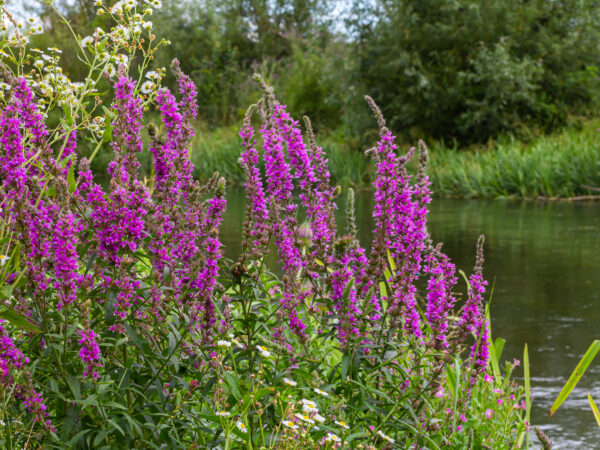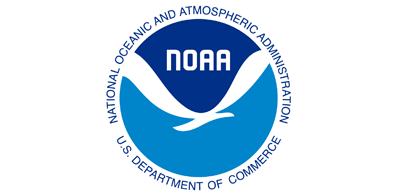PDF coming soon

Purple Loosestrife (Lythrum salicaria)
Species at a Glance
Purple Loosestrife is an attractive but aggressive wetland and riparian invader that was introduced to North America for its beauty and medicinal value. It can rapidly degrade wetlands and replace valuable native species that provide food and shelter for wildlife.
Species Description
Purple Loosestrife is an upright and hardy perennial that can grow up to 7 feet tall. It has a square woody stem and opposite or whorled leaves that are covered by soft fine hairs. Its leaves are heart-shaped with smooth edges and usually appear in groups of three. Purple Loosestrife plants produce a showy display of colorful flower spikes throughout much of the summer, with purple, pink, or white flowers that typically have 5-6 petals.
Native & Introduced Ranges
Purple Loosestrife is native to Europe and Asia and was brought to eastern North America by settlers in the early 1800s for ornamental and medicinal uses. It can be found all throughout the United States and Canada. It is still sold today as an ornamental; however, it is regulated in many states including Pennsylvania. In 1997, Pennsylvania declared Purple Loosestrife a noxious weed, which prohibits the sale, transport, planting, and propagation of Purple Loosestrife and its hybrids and cultivars. Purple Loosestrife currently infests all major watersheds in the Commonwealth.
Biology & Spread
Conversion of wetlands to crop fields, construction of canals for waterborne commerce, and lack of natural herbivores enabled purple loosestrife to spread across inland areas. It is a prolific reproducer, enjoying an extended flowering season and producing up to one million seeds each year. These seeds can remain viable for years until conditions are optimal for germination. Seeds are tiny and can be transported by water, wind, and in the feathers or fur of aquatic birds and mammals. Seeds can also stick to muddy footgear, boats, trailers, and vehicle treads, which can travel long distances and disburse purple loosestrife to new areas.
Habitat
Purple Loosestrife is capable of invading many wetland habitats, including freshwater meadows, tidal and non-tidal marshes, river and stream banks, pond edges, reservoirs, and ditches.
Impacts
Threat to Biodiversity
Purple Loosestrife is very hardy and adapts readily to natural and disturbed wetlands. Once established, it forms dense monotypic stands, crowding out native plants which provide nutritional resources for wildlife. The formation of these monotypic stands also alters the structure, function, and ecological value of the wetland, which can impact waterfowl, mammals, and other aquatic life that relies on the wetland for food and habitat. In addition, Purple Loosestrife’s ability to outcompete native plants has jeopardized some already threatened and endangered native wetland plants in North America, including some orchid species.
Economic Costs
Dense establishments of Purple Loosestrife have impeded water flow in some areas, impacting fish spawning sites and areas where wild rice is grown and harvested. An estimated 190,000 hectares of wetlands, marshes, pastures and riparian meadows are affected in North America each year, with an economic impact of millions of dollars.
Prevention & Control
Physical or chemical control of Purple Loosestrife is crucial to protecting valuable wildlife habitat. Small, localized aggregations may be pulled by hand, preferably before seed set. Other control techniques include water-level manipulation, mowing or cutting, burning, and herbicide application. These control methods are costly and require continued long-term maintenance. In addition, herbicides are non-selective for Purple Loosestrife and can have harmful effects on the environment. For infestations too dense for effective management by other methods, two species of European Galerucella beetles can be introduced as biological control agents. These beetles feed primarily on Purple Loosestrife, significantly reducing the plant’s flowering and seed production.
References
Plant Conservation Alliance’s Alien Plant Working Group. 2005. Purple Loosestrife. <http://www.nps.gov/plants/alien/fact/lysa1.htm >.
Blossey, B. 2002. Purple Loosestrife. Ecology and Management of Invasive Plants Program. < http://www.invasiveplants.net/plants/purpleloosestrife.htm>.
Minnesota Sea Grant. Purple Loosestrife: What you should know, what you can do. < http://www.seagrant.umn.edu/ais/purpleloosestrife_info>



